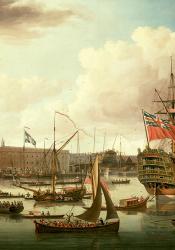The Establishment of the Royal Navy
Cannons had been used on European ships as early as 1338 during the Hundred Years' War, however the technology was still developing and the full might of naval firepower had not yet been realized. During the middle ages, England did not keep a standing peacetime Navy, nor did many other European countries. In 1546, King Henry VIII of England established the first standing Royal Navy, along with multiple dockyards. During his reign, King Henry would build the armada to more than 40 ships, each equipped with superior firepower. The Royal Navy's warships carried 20 heavy and 60 light cannons per ship, the first being the famed flagship, the "Mary Rose." A significant advantage of the Royal Navy was their newly developed breech loading iron cannons, mixed with new cast bronze cannons. These new and incredibly powerful warships were capable of delivering tremendous damage through broadsiding, meaning all the guns on one side of the ship could be fired at once, with a maximum fire rate of 2-3 times in 5 minutes. The British also developed a variety of different projectiles to fire, including the roundshot, the canister shot, and the grapeshot, each of which dealt different levels of damage. Even powerful naval challengers such as the Spanish, who also developed a sizeable navy, would be defeated by the might of the British guns. The Royal Navy's advanced engineering and superior ships would help England become the dominant world superpower from the 16th century to the 20th century. The might of British warships was surpassed only by the United States during the second world war.
Sources:
“Royal Navy.” Wikipedia, Wikimedia Foundation, 19 Feb. 2018, en.wikipedia.org/wiki/Royal_Navy#Role.
“English cannon.” Wikipedia, Wikimedia Foundation, 18 Feb. 2018, en.wikipedia.org/wiki/English_cannon.
“Royal Navy History.” History | Royal Navy, www.royalnavy.mod.uk/news-and-latest-activity/features/history-timeline.
“Naval artillery.” Wikipedia, Wikimedia Foundation, 17 Feb. 2018, en.wikipedia.org/wiki/Naval_artillery#Origins.
Image Source: John Cleveley the Elder [Public domain], via Wikimedia Commons

